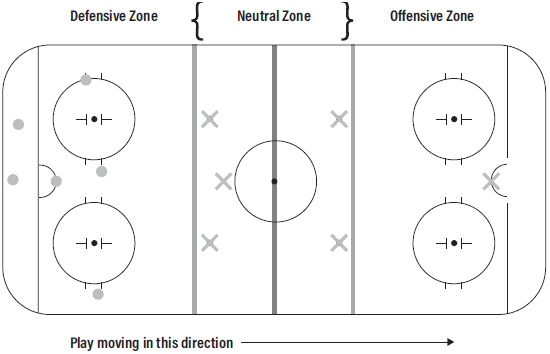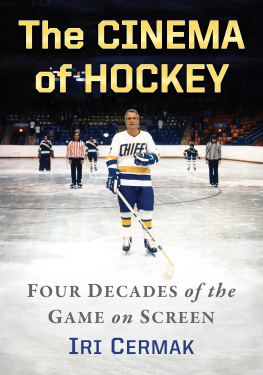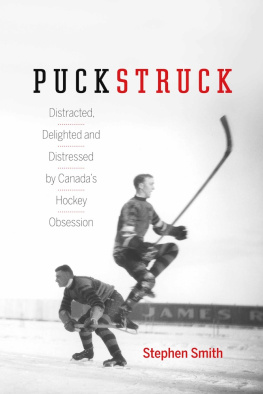

Published by
University of Alberta Press
116 Rutherford Library South
11204 89 Avenue nw
Edmonton, Alberta, Canada t6g 2j4
Amiskwacwskahican | Treaty 6 | Mtis Territory
uap.ualberta.ca
Copyright 2021 University of Alberta Press
LIBRARY AND ARCHIVES CANADA CATALOGUING IN PUBLICATION
Title: Overcoming the neutral zone trap : hockeys agents of change / Cheryl A. MacDonald and Jonathon R.J. Edwards, editors
Names: MacDonald, Cheryl A., editor. | Edwards, Jonathon R. J., editor.
Description: Includes bibliographical references.
Identifiers: Canadiana (print) 20210201738 | Canadiana (ebook) 20210201746 | isbn 9781772125795 (softcover) | isbn 9781772125887 (epub) | isbn 9781772125894 (pdf)
Subjects: lcsh: HockeySocial aspectsCanada. | lcsh: HockeySocial aspectsUnited States.
Classification: lcc gv848.4.c3 o94 2021 | ddc 796.9620971dc23
First edition, first printing, 2021.
First electronic edition, 2021.
Digital conversion by Transforma Pvt. Ltd.
Copyediting by Kirsten Craven.
Proofreading by Mary Lou Roy.
Cover design by Alan Brownoff.
Cover photo: Kieran Block is the first Black Paralympic sledge hockey player in Canada. Courtesy of Hockey Canada. Used by permission.
All rights reserved. No part of this publication may be reproduced, stored in a retrieval system, or transmitted in any form or by any means (electronic, mechanical, photocopying, recording, or otherwise) without prior written consent. Contact University of Alberta Press for further details.
University of Alberta Press supports copyright. Copyright fuels creativity, encourages diverse voices, promotes free speech, and creates a vibrant culture. Thank you for buying an authorized edition of this book and for complying with the copyright laws by not reproducing, scanning, or distributing any part of it in any form without permission. You are supporting writers and allowing University of Alberta Press to continue to publish books for every reader.
University of Alberta Press gratefully acknowledges the support received for its publishing program from the Government of Canada, the Canada Council for the Arts, and the Government of Alberta through the Alberta Media Fund.
This book has been published with the help of a grant from the Canadian Federation for the Humanities and Social Sciences, through the Awards to Scholarly Publications Program, using funds provided by the Social Sciences and Humanities Research Council of Canada.

We dedicate this book to Dr. Colin D. Howell of Saint Marys University in Halifax, Nova Scotia. In 2001, Dr. Howell established the Hockey Conference, one of the inspirations for this book. As he retires from his role in academia, this dedication is a token of our gratitude for his service to the hockey scholar community.
Contents
Preface
CHERYL A. MACDONALD & JONATHON R.J. EDWARDS
ACTORS (e.g., players, administrators, parents, coaches, stakeholders, and officials) within a sporting environment attempt to control situations by establishing and implementing policies, procedures, and rules that implicitly and explicitly create norms that ultimately legitimize the sport. For example, ice hockey (henceforth identified as hockey) in North America is predominately played by white masculine hockey players, or the two most legitimate ways to get to the National Hockey League (NHL) are through the Canadian Hockey League (CHL) and the National Collegiate Athletics Association (NCAA), as indicated by Edwards and Washington (2015). These norms create a closed system where external forces (e.g., social, political, economic, technological, and legal) are shielded from the actors within the internal environment, which restricts these actors from adapting and changing (DiMaggio & Powell, 1983; Edwards, Mason, & Washington, 2009). Specifically, hockey in North America operates as an institutionalized sporting environment where inclusionary and exclusionary norms are created. This specific type of sport system can be understood through the analogy of the neutral zone trap.
The neutral zone trap is an on-ice defensive tactic that is employed as a means of preventing the offensive team (i.e., the team with the puck) from entering into the defensive teams end to score a goal. The defensive players position themselves in the neutral zone in a manner that inhibits the offensive team from gathering speed and then disarms the player in possession of the puck (see Figure P.1). Put differently, the central area of the ice surface is closed off to the opposing team and a boundary is created.
Figure P.1: The Neutral Zone Trap

Within the context of this book, the neutral zone trap comprises the defensive institutional norms (i.e., the players labelled X in Figure P.1) that restrict the marginalized offence (i.e., the players labelled with a shaded O in Figure P.1) from succeeding. The boundaries established in the neutral zone trap can be penetrated or overcome when the offensive players, which we call agents of change , are able to mobilize up the middle of the ice and disrupt the trap, which is interpreted metaphorically as institutional norms.
Evidence of attempts to overcome barriers in hockey exist in the development and growth of organizations such as the You Can Play Project and Black Girl Hockey Club, which seek to normalize the participation of racial, sexual, and gender minority groups that have typically been misunderstood and excluded in the community. One complete example of how institutional norms are created and overcome can be understood through the lengthy career and eventual firing of hockey media pundit Don Cherry. Cherry was a divisive voice in Canadian hockey culture on the television program Hockey Night in Canada , where he would make inflammatory comments about women, concussions, and violence, among others. Allain (2015) argues that, since 1982, Cherry used his platform to valorize the experiences of white working-class menmen that hefeels are at risk from new social forces (for example, feminism, immigration, and the movement away from physical labour) that look to devalue their cultural positions (pp. 109110). In short, Don Cherry helped to establish a neutral zone trap that normalized beliefs about who has value in the hockey community.
Despite still having a tenable cult following, Cherry was swiftly removed from his position in late 2019. Although Cherry has perhaps always made contentious comments on television about subjects like race and gender, the one that led to his termination was an accusation that recent immigrants to Canada allegedly ignore Remembrance Day and the symbolic meaning of the poppy. His employer, Sportsnet (a division of Rogers Communications), issued an apology for the remarks, noting that Cherrys comments were not in keeping with the networks philosophy that sport should bring people together (Sportsnet, 2019). In this instance, Sportsnet acted as an agent of change that opened up a laneway for the inclusion of the individuals that Cherry, a gatekeeper, had previously disparaged.
This book is a collection of essays that sheds light on agents of change in hockey who are confronting or have overcome the neutral zone trap. In other words, the essays address the pursuit of inclusion and acceptance for those typically excluded (Allain, 2008, 2012; Robidoux, 2001; Szto, 2016). The book grapples with the established norms that create and reinforce stigmas in hockey and the broader society. The combination of stories and research illustrates how different empirical settings disrupt the institutional arrangements (or break down the trap) as a means of implementing change within hockey. It is through these uncommon voices that the barriers begin to come down. In the broader societal context, similar institutional barriers relate to challenges faced by Indigenous communities in Canada and the Truth and Reconciliation Commission (TRC), shortcomings in gender equity and equality, and equality for individuals with disabilities. These issues are not new to society, yet they continue to be perpetuated. Nonetheless, many of these minority groups and individuals have increasingly begun to speak out, which is disrupting restrictive norms.
Next page










